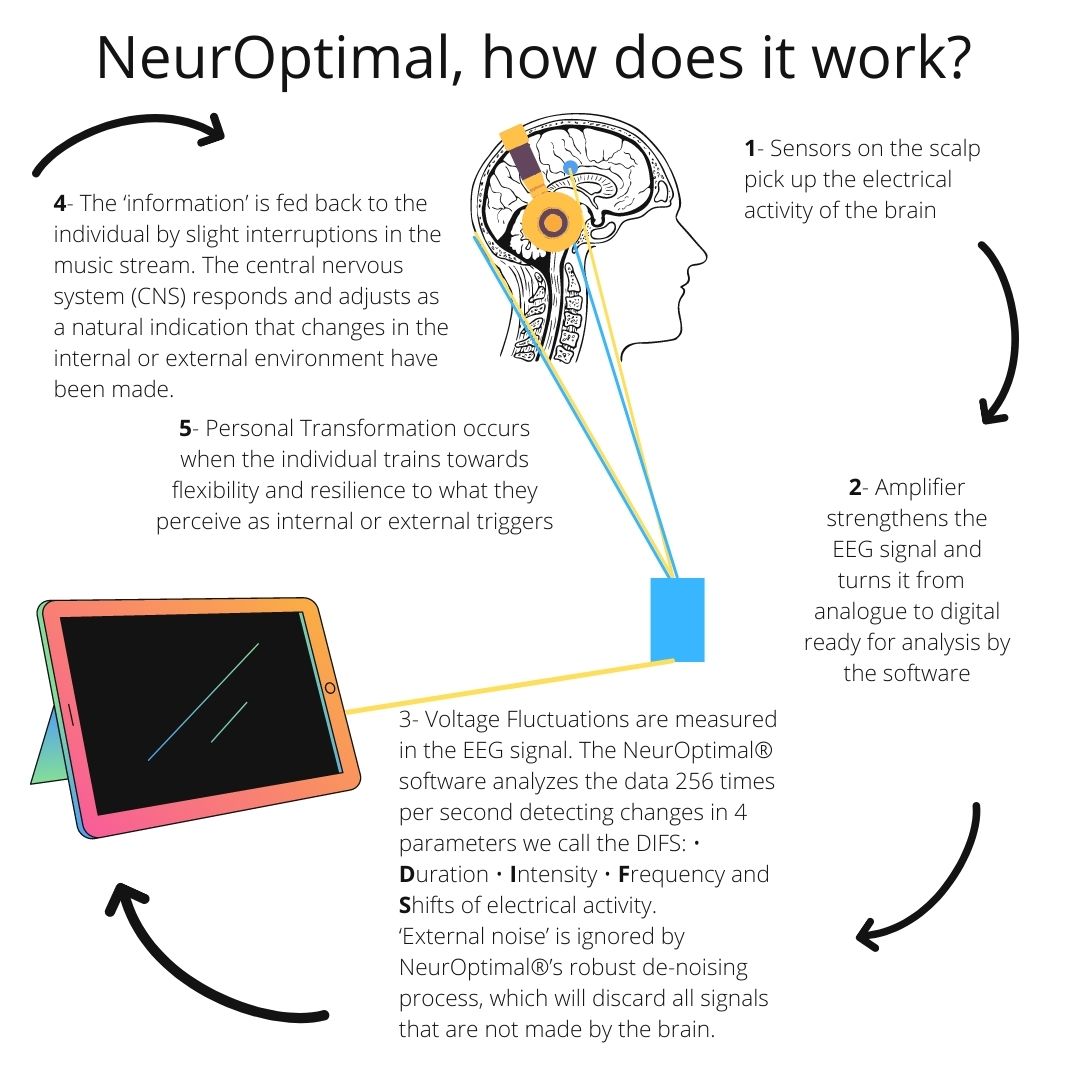If you’ve read my general website page on NeurOptimal and you’re still thinking, ‘I don’t get it, how does NeurOptimal work?’ Let me explain a little more. I’m aware that NeurOptimal Neurofeedback presents a challenging paradigm shift for many who are looking to improve performance or emotional regulation. It is an interesting mix of brain science, mindfulness/Buddhist philosophy and cognitive science, so bear with me as I go a little deeper with it.
Brain and Central Nervous System
To understand NeurOptimal you need to have a little understanding about the brain and nervous system and what their role is. As a general rule the brain and Central Nervous System as an integrated system are wired to detect differences that occur inside and outside of us so that they can put into motion any necessary actions to help us to stay out of danger and discomfort. When it comes to the nervous system the actions I am talking about are not conscious ie not ones we need to think about first. Thinking is very slow and many circumstances need us to react with millisecond precision. If you trip and start falling down the stairs you don’t want to wait to have a thought process that directs you to grab the handrail because you’d already be on the floor at the bottom of the stairs. Instead you need your nervous system reflexes and brain computations to grab that handrail before you consciously think about it. Most of how we operate and make decisions is happening at this level, outside of conscious awareness. Us humans like to think we are in control of our decisions but there are far too many studies now showing that the decisions we make often precede our conscious though about the decision. This means that our brain and nervous system are making those decisions for us based on our past learning and preferences.
NeurOptimal therefore harnesses the speed of computing power to help your brain and nervous system make adjustments to the feedback their will receive at their natural operating speed.
Perception, Learning and Memory
To Break down further how NeurOptimal works we need to understand a little more about perception, learning and memory and how our past experiences inform the present.
Central to how each of us operates are perception, learning and memory. This process is ever evolving but along the way the brain creates maps and models of our experiences so that we can predict future scenarios and apply our learning in order to minimise discomfort and danger. This helps us with efficiency and survival because imagine if we had to figure out how to use a fork at every meal time!
Prior learning is essential but there are also times when our learning needs to be updated. Let’s say that you were once bitten by a white dog in childhood. In order to stay safe and comfortable in the world you generalised your learning to all white dogs and from many years you had a strong aversion to these white furry creatures and avoid them at all costs. Then one day in adulthood you end up dating someone who absolutely loves white dogs and has two of them. This would be a really good time to update that earlier learning. You spend time with your partner and their white dogs, your perceptions of white dogs generally starts to change and you create new memories about pleasant times spend with these specific white dogs. These memories turn into new learning your fear of one past white dog is put into perspective. In essence you have updated your belief created in the past by reality testing it in the present.
We all have many habits, beliefs and reaction patterns that define us, some of these are helpful and others less so. Habits and patterns that arise at one point in our lives can endure beyond their usefulness, even when circumstances have obviously changed because memory keeps them going. Memory can be both explicit (consciously accessible and obvious) and implicit (a sense, feeling or physiological response) so we don’t have to be conscious of prior learning and experience for memory to keep us reacting to it.
NeurOptimal can help shift the way you feel and think because it is helping your brain become efficient and optimised for present moment functioning. What I hear time and time again with NeurOptimal is people saying they feel more present and are more able to observe themselves and their reactions in the present. This provides them with the opportunity to reassess and ultimately change their perceptions and reactions, leading to new learning and in time, update their memory about who they are and how they cope.
So, How does NeurOptimal Work with Present Moment Focus?
NeurOptimal is a very advanced tool for helping your brain and perception readjust to the needs of the present moment. During the 33 minute training session, each time the brain is about to do something new, the music stream will be simultaneously interrupted by a tiny break, which will happen up to 256 times per second. This break in the music is the neurofeedback ie a piece of auditory information, which prompts the brain to continuously pay attention to itself and what it is doing millisecond by millisecond throughout the training session.
Let me explain this another way. Let’s say you are quickly walking down the street, fully focussed on an important task you are about to go and do. While you are walking you hear someone call your name, you look up and see a friend waving at you from the other side of the street. So here we have an example of what NeurOptimal is doing – in this scenario you have to make a decision about this new information coming at you (your friend calling you name) which happens to be timed with you fully focussed on another task you need to do. Your decision about how to proceed will be based on how important the original task is vs this new information and possibility of an alternative task ( stopping to talk with your friend). Maybe you need to signal to your friend that you need to get on with something or maybe you decide that the previously important task is not really that important. And so it is with NeurOptimal – if the original task serves no purpose, especially in the context of having a relaxing neurofeedback session, then your brain will inevitably relinquish that task as surplus to requirements for that moment.
This is why NeurOptimal is so effective for most people. The truth is, most of the time we are busier and doing more than we need and this is what causes anxiety and burnout. Neurofeedback is often referred to as ‘Meditation on Steroids’ because over the course of 33 minute training session it will bring your brain back to the present in the region of 506,800 times!
Over a series of sessions, the brain is being trained how to assess and reassess its own activity, in real time, so that it upgrades it’s efficiency and adaptiveness in an optimised way. For many this feels like a reboot and a reduction in stress symptoms that is hard to achieve in any other way.
How Does NeurOptimal work technically?
Below is a diagram of the NeurOptimal neurofeedback training cycle which relays brain voltage information to the software in the tablet which in turn relays the neurofeedback via a break in the music stream. The brain then automatically makes its adjustments as a normal process of adaptation to new information while maintaining balance. As indicated in point 5 below, the brain achieves optimisation and transformation when it has done enough training to becomes flexible and resilient in its ability to adapt to new information.

